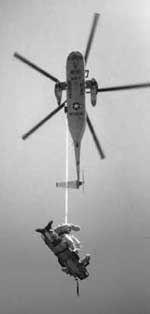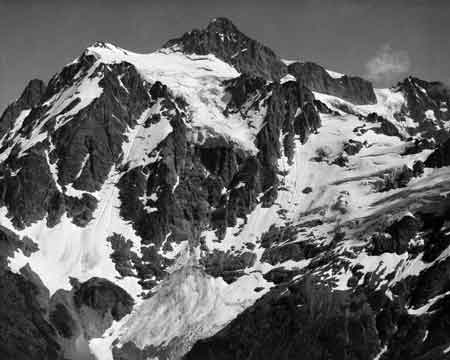|
North Cascades National Park Service Complex Climbing Notes 1999 |
National Park Service U.S. Department of the Interior |

|
| 1998 Search and Rescue Incidents |
U.S. Navy Rescue helicopter,
training
mission with
North Cascades National Park rangers.

North Cascades National Park's search and rescue (SAR) crews responded to 44 incidents during 1998. Climbers failing to check in on their Voluntary Climber Register triggered many of these responses. Nine of the incidents were significant efforts to evacuate one or persons with injuries in difficult or technical terrain. Total unprogrammed or emergency cost to the park for these evacuations was $9665. This does not include expenses covered by volunteer rescue teams or military response. There were no documented incidents on the Mt. Baker District.
Six of the incidents involving climbers are summarized below, highlighting the natural hazards and practices that contributed to or caused the accidents. It is noteworthy that in the North Cascades, non-technical approach areas disable climbers as often as the actual climbing routes.
Mount Shuksan, June 15.
A party of seven planned a two-day trip to climb the Sulphide Glacier route. Prior to reaching a base camp, the group became unintentionally separated. On the second day five of the group summitted in poor weather, (unknowing that the other two had hiked out the previous day) but became disoriented in fog on the descent. They spent an unintended second night out with day gear only. Improved weather the third day allowed the five to hike out with a search crew. The group attributed their difficulties to summit "fever" despite poor weather, little attempt to stick together, and widely varying experience levels.
The Triad, June 24.
Responding to an overdue climbing register for a party of two on Eldorado via Sibley Pass, rangers found the pair bivouaced near their accident site on the Triad's southwest side. While roped, they had taken a fall into a moat while descending a snow-filled gully. Poor weather prevented helicopter evacuation. Both climbers were ambulatory, but sick and weak. With assistance from the rescue team, the pair hiked out. Hospital evaluation confirmed internal injuries, which had resulted in their weakened state.
Boston Basin, July 4.
After completing a multi-day trip on peaks based from Boston Basin, a climber slipped on wet rock while crossing a creek, injuring a knee and rendering him unable to walk. Party members and a rescue team evacuated him in a day-long effort down the Boston Basin approach route. This involved belayed carries, rappels and lowering of the climber.
Forbidden Peak, August 26.
A party of four was on Forbidden's East Ridge when the leader suffered a belayed fall when a hold broke loose. No protection points were in place on the ridge and the climber fell approximately 40 feet to the Boston Basin side of the East Ridge. Two partners rappelled to the injured's location and assisted as the belayer lowered the climber to a small ledge. The fallen climber's injuries included an open leg fracture and numerous head lacerations. One party member descended to summon help. Rescuers were helicoptered to the base of the route, climbed to the location and packaged the climber for evacuation. A military helicopter then hoisted the climber from the ledge to the Cascade River Road for ambulance transport.
Mount Shuksan, September 6.
Rescuers were alerted to an accident in the Fisher Chimneys on Mount Shuksan via a cell phone call from a climber just prior to dark. The two were descending through the Chimneys unroped when one fell, tumbling approximately 80 feet through a gully to a ledge. The partner found him with an open arm fracture, severe back pain and inability to move his legs. A rescue team responded during the night, but helicopter evacuation was not possible until daylight. The injured climber and a rescuer were short-hauled via helicopter cable to the Curtis Glacier, where the climber was transferred to a medical helicopter. This climber later attributed his accident to letting his guard down during the descent and hurriedly down-climbing to beat darkness.
Mount Logan, September 7.
Two climbers were descending the approach to Mount Logan's north side when one triggered a rockslide on a moraine, which partially buried him. The partner was able to free the climber, who sustained hand, leg and rib injuries, but remained able to walk. Both descended to Fisher Creek trail, where the partner hiked out ahead and summoned assistance.

| Carrying A Cell Phone? |
Packing a telephone with the climbing gear is a fairly recent development, but now, not uncommon. Climbers carrying cell phones are finding that in many (mostly high elevation) areas of the North Cascades, reception can be quite good. However, others attempting to use a cell phone as an emergency communication tool have found reception to be fickle, at times with unexpected consequences.
Cell phone use also remains controversial amongst wilderness purists. While agencies generally have not taken a position, from a practical standpoint, rangers have observed that the technology is definitely influencing the search and rescue business for better or worse.
In several incidents, phones have successfully alerted rescuers to mountain accidents in North Cascades National Park, allowing rescue to begin hours before it would have without phone notification. But with equal frequency, the use of a phone in an initial distress call has resulted in what is referred to as a "bastard search" -- a response by rescuers for a situation in which their assistance is unnecessary.
For those climbers packing a phone to potentially use in the event of an accident, the following information could prove useful:
- If you are in North Cascades National Park the best number to call is Park Dispatch at (360) 873-4500, ext. 37. Dialing 911 or the appropriate County Sheriff's office will work, but will take longer, as they then call the North Cascades dispatch when it is clear the caller's location lies within the Park.
- Always state your location and cell phone number early in the call in case connections fail and a callback is necessary.
- Be aware that if you get through once, it does not mean a connection can be made a second time, even from the very same location. Consequently, it is important to communicate clearly the purpose of your call in your first connection, and if you are requesting assistance. Depending on circumstances, a plan to "call back" later without a clear first call might very well give you a rescue response you didn't intend to initiate. Agencies with emergency response duties are required to investigate and resolve all reported incidents.
As phone technology advances, the unsuredness of dependable connections in remote areas may be eliminated. But for now, climbers are cautioned to not substitute the phone for preparedness. And if putting one to use in summoning help, be aware that a well-planned call can make a lot of difference.

| Fixed Anchor Controversy |
Those who keep abreast of issues in the climbing community have likely followed the controversy that erupted over the past year regarding fixed anchors in Wilderness areas. While never fully developed into clear direction for local Forests, the US Forest Service developed national policy that would ban the use of fixed anchors (from rappel slings to bolts) in designated Wilderness areas.
The National Park Service has not addressed this issue with a Service-wide policy, although some Parks with significant climbing activity have climbing management plans specific to their resource. Nevertheless, media reaction to the USFS policy quickly spread predictions that climbing nationwide was on the verge of prohibition. This included a Climbing magazine article (Nov 1998) announcing climbing as endangered within the Stephen Mather Wilderness (North Cascades National Park).
In actuality, there are currently no specific plans in either North Cascades National Park or Mt. Baker-Snoqualmie National Forest to implement a ban on climbing anchors. Of greater concern are issues such as human waste in the alpine and glaciated environment, and the proliferation of approach trails that often lead to severe erosion. Climbers are, of course, expected to travel and climb with as little impact as possible. Rangers patrolling climbing areas do remove excess, old webbing and all flagging found. Climbers are encouraged to do this also.
Individuals and climbing organizations concerned with access issues will do well to continue involvement and promotion of Leave No Trace principles. It is a likelihood that if we are not successful in this arena, as impacts increase, permit systems get stricter and fewer will be allowed to go. Wide practice of LNT translates to greater freedom and fewer restrictions. Mountaineering has a long tradition and history in the North Cascades, and with user responsibility, should have a future as well.
| Briefly |
1999 Snowpack
The anticipated La Nina winter weather pattern did indeed result in a phenomenal snowpack. April 1999 snow survey sites within North Cascades National Park (maintained by the Natural Resources Conservation Service) gave these figures: Sites draining to the Skagit River show April's snowpack at 182% of the average, and 202% of last years April reading. Figures for sites in the Nooksack drainage show 182% of average and 231% of 1998.
Sulphide Glacier Camps
In 1998 a composting toilet was in operation for it's first season just below the Sulphide Glacier on Mount Shuksan. Feedback from repeat climbers to this camp resulted in the composter's relocation to a higher point in the same camping area. Climbers are encouraged to camp in this vicinity, using the composter in order to preserve water resources and snow camping aesthetics.
Climbing Video Available
A 20 minute video focusing on climbing safety and Leave No Trace techniques in the alpine setting is available for viewing in the Wilderness Information Center in Marblemount. Check it out!
noca/climbing-notes/1999.htm
Last Updated: 28-Oct-1998